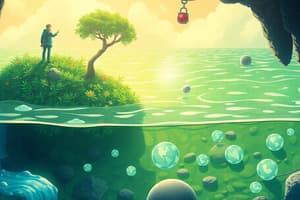Podcast
Questions and Answers
What is the origin of the word 'mukes'?
What is the origin of the word 'mukes'?
- From Greek for 'fungi' (correct)
- From Greek for 'algae'
- From Greek for 'plants'
- From Greek for 'bacteria'
Which Phylum includes mushroom, toadstools, bracket fungi and puffballs?
Which Phylum includes mushroom, toadstools, bracket fungi and puffballs?
- Basidiomycota (correct)
- Chromista
- Ascomycota
- Fungi Imperfecti
What is the role of saprophytic fungi in the ecosystem?
What is the role of saprophytic fungi in the ecosystem?
- They produce oxygen through photosynthesis
- They produce toxins to harm humans
- They decompose dead and decaying organic material (correct)
- They produce antibiotics to cure diseases
What is the significance of mycorrhiza in plant-fungus symbiosis?
What is the significance of mycorrhiza in plant-fungus symbiosis?
What is the role of fungi in cheese manufacturing?
What is the role of fungi in cheese manufacturing?
What is the role of Saccharomyces yeast in commercial food production?
What is the role of Saccharomyces yeast in commercial food production?
What is the significance of lichens in the ecosystem?
What is the significance of lichens in the ecosystem?
What is the role of fungi as decomposers in the ecosystem?
What is the role of fungi as decomposers in the ecosystem?
What is the significance of mycorrhiza in plant growth?
What is the significance of mycorrhiza in plant growth?
What is the role of fungi in nature?
What is the role of fungi in nature?
Flashcards are hidden until you start studying
Study Notes
Eutrophication
- Large population of algae encourages the growth of aerobic bacteria, which multiply rapidly and use up all the O2 dissolved in the water, leading to the death of fish and other organisms.
- Caused by high levels of nutrients from sewage or leaching of fertilizer from agriculture land.
- Certain marine algae produce toxins which accumulate in the bodies of shellfish, leading to potential source of food poisoning when consumed.
Red Tide
- Caused by dinoflagellates (Phylum Dinoflagellata), one of the most important groups of producers in marine ecosystem.
- The bloom colors the coastal waters orange, red or brown.
- Human-produced coastal pollution has been linked to these, whereby abundant nutrients from the pollution sources increase the dinoflagellate numbers.
- Some dinoflagellates from red tides produce a toxin.
Kingdom Fungi
- Multicellular eukaryotes, lacking chlorophyll and being non-photosynthetic, heterotrophic, and either parasites, saprotrophs, or mutualists.
- The body usually consists of mycelium, a network of fine tubular filaments (hyphae).
- Non-motile, flagella and cilia are absent.
- Stored carbohydrate is glycogen, not starch.
Phylum Ascomycota and Phylum Basidiomycota
- Example of Phylum Ascomycota: Penicillium.
- Example of Phylum Basidiomycota: Agaricus.
Role of Fungi
Decomposers
- Saprophytic fungi feed on dead and decaying organic material in the soil, recycling nutrients (phosphate, ammonia, sulfates, water) to be taken up by plants.
Symbionts
- Mycorrhiza: symbiotic association between fungus and plant root, where fungus receives organic nutrients from the plant, and helps absorb water and minerals.
- Lichens: symbiotic association of fungi and algae, where algae provide carbon compounds and organic nitrogen, and fungi provide a suitable environment for growth, protection, and retain water and minerals for algae to absorb.
Pathogens
- Almost 30% of all known fungal species are parasites, mostly on plants, having huge ecological and economical effects.
- 10-15% of global harvest is affected by fungal attack, with examples of wheat and corn fungal diseases, smuts, and rusts.
- Some fungi are toxic to humans, such as Claviceps purpurea, which forms ergots on rye, causing ergotism if consumed in large quantities.
Commercial Food Production
- Edible mushrooms are popular as food, eaten raw or cooked.
- Fungi are used in cheese manufacturing, combining activities of bacteria and fungi to ripen and improve the flavor and texture of cheese.
- Saccharomyces yeast are used commercially in the production of alcoholic beverages and bread, fermenting sugars to alcohol and CO2 under anaerobic conditions.
Pharmaceutical Properties
- Antibiotics, such as penicillin, are extracted from fungi, inhibiting the growth of or killing other microorganisms.
- Effective against bacteria that cause pneumonia, meningitis, syphilis, gonorrhea, and sepsis of wounds.
Studying That Suits You
Use AI to generate personalized quizzes and flashcards to suit your learning preferences.




